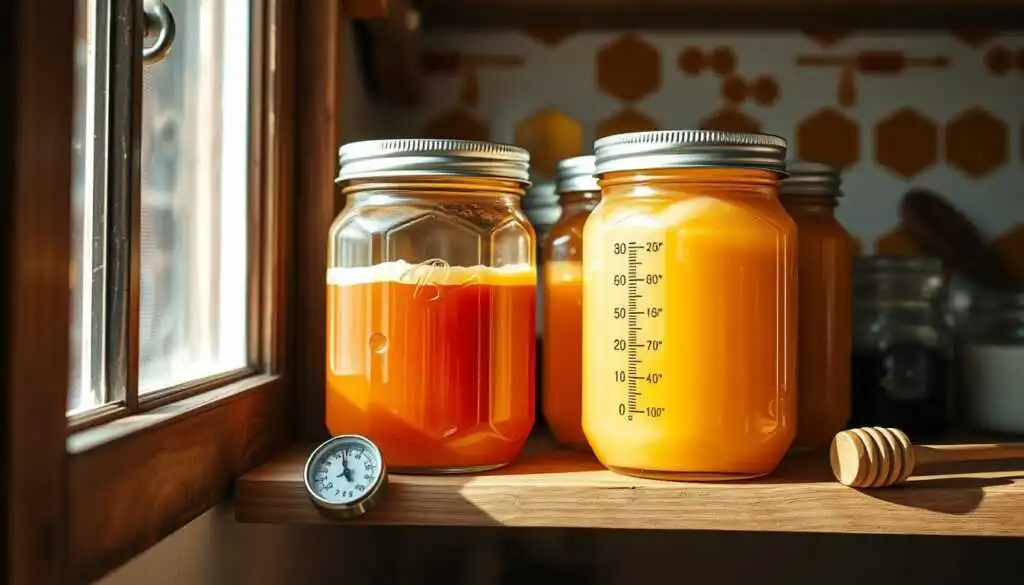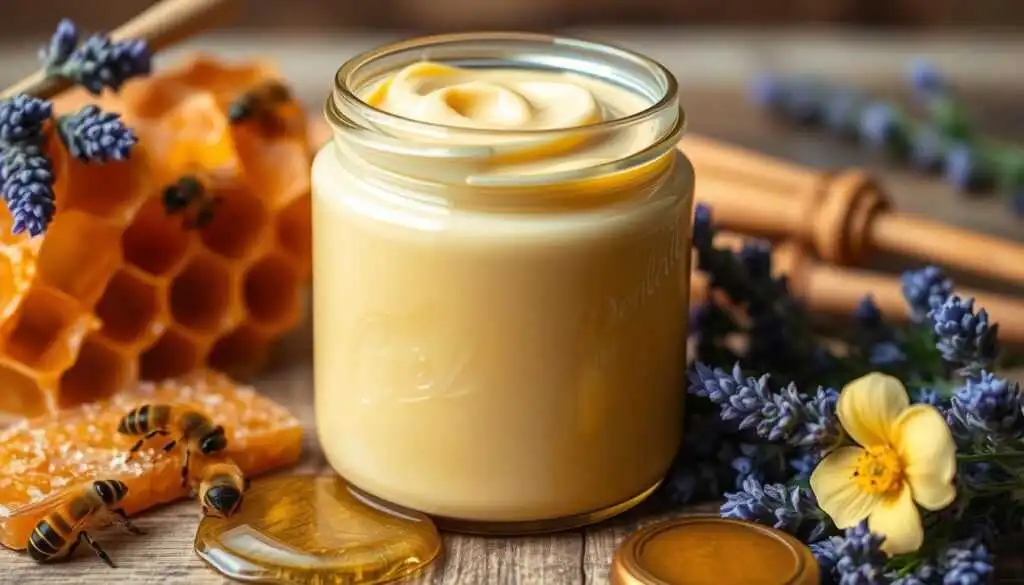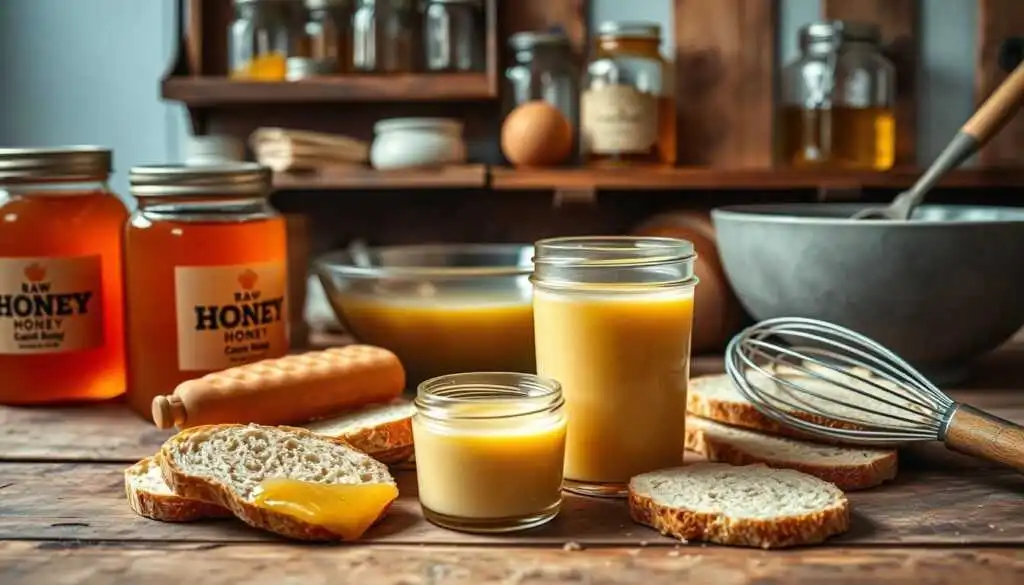Did you know you can make creamed honey at home? This is often referred to as whipped or spun honey. This natural honey product is smooth and spreadable. It’s great on toast, in drinks, or in recipes.
By controlling how honey crystallizes, you can turn it into a creamy treat. It’s easy and fun to make.
Table of Contents
Understanding Creamed Honey: What It Is and Its Benefits
Creamed honey, also known as granulated honey or honey butter, is regular honey that has been crystallized. This process makes it smooth and spreadable, unlike liquid honey. It’s easier to use in cooking because of its texture.
Differences Between Regular and Creamed Honey
Regular honey is liquid, while creamed honey is thick and spreadable. This is because of the crystallization of glucose in creamed honey. It feels smoother in your mouth and is easier to use in recipes.
Health and Usage Benefits
Creamed honey keeps all the good stuff from raw honey, like antibacterial and antioxidant properties. It’s great as a sweetener or topping for many dishes. It’s also a tasty alternative to butter or jam on toast or pancakes.
Natural Crystallization Process
The crystallization of creamed honey happens when glucose in honey solidifies. This creates a unique texture and consistency. It’s often called “whipped” or “spoonable” honey.
“In 1928, Professor Elton J. Dyce of Cornell University introduced a new method for processing honey to create creamed honey, which has a soft, smooth texture, a thick consistency, and a light, creamy color.”
Essential Ingredients and Equipment for Making Creamed Honey
To make creamed honey at home, you need just a few things. You’ll need crystallized honey and liquid honey, mixed in equal parts. This mix gives you the right texture and taste. Feel free to customize it with flavors like cinnamon or vanilla to suit your taste.
For making creamed honey, a clean glass jar is perfect for storing it. You’ll also need a stand mixer or blender with a whisk. This helps whip the honey into a creamy state. Make sure all your tools are clean and dry to keep the honey pure.
| Ingredient | Amount |
|---|---|
| Crystallized Honey | 1/2 cup |
| Liquid Honey | 1/2 cup |
| Optional flavorings (such as cinnamon, almond extract, or vanilla extract) can be added in amounts of | 1-2 teaspoons |
With these basic honey processing ingredients and tools, you can make your own honey cream. Now, let’s look at how to turn honey into a creamy treat.
The Science Behind Honey Crystallization
Honey crystallization is a natural process. It happens when glucose molecules in honey separate from water and form solid crystals. This change from liquid to solid is influenced by temperature, honey composition, and impurities.
Role of Temperature in Crystallization
Temperature is key in honey crystallization. Honey starts to solidify at temperatures below 50°F (10°C). The process speeds up as the temperature drops further. The best temperature range for quick crystallization is between 50°F and 59°F (10°C and 15°C).
Crystal Formation Process
The crystallization of honey starts with tiny seed crystals. These crystals attract and trap more glucose molecules. As they grow, the honey solidifies.
Factors Affecting Crystallization Speed
- Honey Type: Different kinds of honey crystallize at different rates. Honeys with more glucose, like clover or raspberry, crystallize faster.
- Temperature: Cooler temperatures speed up crystallization, while warmer temperatures slow it down.
- Impurities: Particles like pollen or beeswax can help crystallization happen faster.
The composition of honey, including its sugar and mineral content, affects crystallization. Knowing the science behind honey crystallization helps beekeepers and honey lovers enjoy this natural process.
How to Make Creamed Honey at Home
Creamed honey, also known as whipped or spun honey, is a tasty spread you can make at home. It’s made by blending solid and liquid honey to get a smooth, creamy texture. Here’s how to make your own creamed honey recipe in your kitchen.
- Start with equal parts crystallized and liquid honey. This ensures the proper crystallization process.
- Mix the honey in a stand mixer or blender for about 20 minutes on medium speed. The long mixing time is crucial for developing the desired creamy texture.
- After the initial mixing, let the honey rest for an hour. This allows the air bubbles to rise to the surface.
- Whip the honey again for another 20 minutes. This additional mixing helps incorporate the air bubbles and further refine the whipped honey consistency.
- Pack the creamed honey into clean, dry jars and store it at room temperature. Over the next few days, the honey will continue to thicken as more bubbles rise to the top.
The key to successful creamed honey is the controlled crystallization process. By creating many small crystals, you prevent the formation of large, undesirable crystals that can ruin the smooth, spreadable texture. With a little time and effort, you can enjoy the delightful, creamy goodness of homemade spun honey anytime.
“Turning honey into a velvety, creamy delight is a truly satisfying experience for the senses.”
Proper Mixing Techniques and Duration
Making creamed or whipped honey requires careful mixing and the right time. Start by blending crystallized and liquid honey on medium speed for 20 minutes. This step adds air and breaks down the honey, making it smooth and creamy.
Initial Blending Process
First, mix the crystallized and liquid honey in a stand mixer or hand mixer. Use medium speed for 20 minutes. This step is key for the right texture and look of the whipped honey.
Optimal Mixing Times
After blending for 20 minutes, let the honey rest for an hour. This rest time lets the air bubbles settle and the honey solidify. Then, blend again on medium speed for 20 minutes. The whole process takes about 40 minutes.
Signs of Successful Whipping
When the whipped honey is done, it will be thicker and creamier, with a lighter color. It should hold its shape when scooped. This shows the honey has been whipped successfully.
The key to creating a perfect batch of creamed honey lies in the proper mixing techniques and durations.
Storage Methods and Temperature Control
Keeping your homemade honey storage at the right temperature is key. This helps keep it creamy and of high quality. Here’s how to do it right:
- Keep your creamed honey in sealed, airtight containers at room temperature. This is between 70-80°F (21-27°C). This range keeps it creamy for weeks.
- Don’t put creamed honey in the fridge. Cold can make it hard and crystallize quickly. A wine cooler or a cool basement is better.
- The best temperature for storing creamed honey is 50-57°F (10-14°C). This helps it form small, uniform crystals. This makes it smooth and spreadable.
After it’s set, you can store it at room temperature or in the fridge. It’s up to you. But remember, the fridge will make it firmer over time. Room temperature keeps it creamy longer.
“When honey is heated above 100°F (38°C), its flavor starts to change, and at temperatures exceeding 120°F (49°C), its valuable enzymes begin to deteriorate and lose their effectiveness.”
By following these honey storage and honey preservation tips, your homemade creamed honey will stay delicious for weeks.

Adding Flavors and Variations to Creamed Honey
Creamed honey is a versatile delight, offering endless flavor possibilities. You can add a touch of spice or sweetness to make it your own. Let’s look at some popular flavor combinations and natural additives to make your honey unique and delicious.
Popular Flavor Combinations
Making creamed honey at home lets you try different flavors. Here are some favorites:
- Cinnamon – It adds a warm, comforting touch to honey’s sweetness.
- Vanilla – It complements honey’s floral notes, making it rich and indulgent.
- Cocoa Powder – Adding raw cacao powder gives a creamy, chocolatey twist.
- Zest from citrus fruits like lemon, orange, or grapefruit brings a bright and refreshing flavor.
- Herbs – Rosemary, thyme, or lavender can add an earthy, herbaceous flavor.
Natural Additives and Ingredients
You can also try natural ingredients to enhance your creamed honey. Here are some ideas:
- Dried Fruits – Chopped apricots, cherries, or figs add a fruity, chewy element.
- Nuts and Seeds – Chopped almonds, walnuts, or chia seeds add a delightful crunch.
- Spices – Try ground ginger, cardamom, or a hint of cayenne for heat.
- Essential Oils – A small amount of peppermint or lemon essential oil can add a subtle aroma.
When adding flavors or ingredients, keep the moisture right to keep your honey smooth. Experiment and enjoy making your own unique flavored honey creations.
| Flavor Pairing | Quantity to Add (per 12 oz honey) |
|---|---|
| Cinnamon | 1-2 tsp ground cinnamon |
| Vanilla | 1 tsp pure vanilla extract |
| Cocoa Powder | 2-3 tbsp raw cacao powder |
| Citrus Zest | 1-2 tsp freshly grated zest |
| Dried Herbs | 1-2 tsp finely chopped |
“The magic of creamed honey lies in its versatility, allowing it to be infused with a variety of delightful flavors. Get creative and let your palate lead you on an exciting journey of flavor exploration.”
Troubleshooting Common Issues
Making the perfect creamed honey can sometimes be tricky. A bit of troubleshooting can help you address and fix these challenges. Let’s dive into some typical problems and discover the solutions to tackle them.
Honey Not Solidifying
One common problem is when honey doesn’t solidify. Often, it’s because the temperature is off. Creamed honey needs a temperature between 55-60°F (13-16°C) to set right. Make sure your honey is whipped and stored in this range.
Grainy Texture
A grainy texture can happen if you use big seed crystals. For a smooth texture, use finer crystals or even commercial creamed honey as a starter. This will help create smaller, more even crystals.
Separation Issues
Separation in your creamed honey means it wasn’t mixed well enough. To fix this, remix the honey. Make sure to whip it as recommended and keep the temperature right during setting.
By tackling these honey crystallization problems and keeping the right honey consistency, you can make creamy, spreadable honey every time. It’s a joy to enjoy.

“The key to achieving perfectly creamed honey lies in mastering the details—temperature, mixing technique, and patience.”
Conclusion
Making homemade creamed honey is easy and rewarding. You only need honey and seed crystals. With a little patience, you can make your special honey.
Try different honey types to find your favorite. Creamed honey is smooth and tastes milder than regular honey.
Creamed honey is great for many dishes. Use it as a spread for toast or as an ingredient in baking. It adds sweetness to meats and veggies too.
It’s perfect for those who want a unique honey or an easy spread. Making your own creamed honey is worth the effort. Relish the journey and take pleasure in the delectable outcome.
FAQ
What is creamed honey?
Creamed honey is a type of honey that’s smooth and spreadable. It’s made by controlling how honey crystallizes, without adding anything extra.
How does creamed honey differ from regular honey?
Creamed honey is smoother and less messy than liquid honey. It’s just as healthy, but easier to spread and measure.
What are the benefits of creamed honey?
You can spread creamed honey on bread, mix it into drinks, or use it in recipes. It tastes milder than liquid honey, making it more versatile.
How does the natural crystallization process work?
Honey crystallizes naturally when glucose molecules form crystals. Temperature is key, and crystals start growing from seed crystals.
What equipment and ingredients are needed to make creamed honey?
You’ll need crystallized honey, liquid honey, and a clean container. A stand mixer or blender with a whisk is also needed.
What is the process for making creamed honey at home?
Mix equal parts of crystallized and liquid honey. Then, whip it for about 40 minutes to get a creamy texture.
How should creamed honey be stored?
Store creamed honey in sealed containers at room temperature. Store it in a cool, dry location, such as a basement. Avoid refrigerating it, as it becomes too firm.
Can cream honey be flavored?
Yes, you can flavor creamed honey with cinnamon, cocoa, vanilla, herbs, or dried fruits. Add these during mixing.
What are some common issues with making creamed honey?
Issues include honey not solidifying (wrong temperature), grainy texture (use finer crystals), and separation (mix better).

